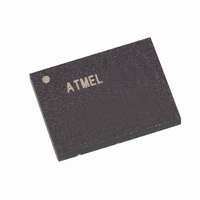AT45DB321C-CNU Atmel, AT45DB321C-CNU Datasheet - Page 8

AT45DB321C-CNU
Manufacturer Part Number
AT45DB321C-CNU
Description
IC FLASH 32MBIT 40MHZ 8CASON
Manufacturer
Atmel
Datasheet
1.AT45DB321C-RU.pdf
(40 pages)
Specifications of AT45DB321C-CNU
Format - Memory
FLASH
Memory Type
DataFLASH
Memory Size
32M (8192 pages x 528 bytes)
Speed
40MHz
Interface
SPI, 3-Wire Serial
Voltage - Supply
2.7 V ~ 3.6 V
Operating Temperature
-40°C ~ 85°C
Package / Case
8-CASON
Lead Free Status / RoHS Status
Lead free / RoHS Compliant
Available stocks
Company
Part Number
Manufacturer
Quantity
Price
Part Number:
AT45DB321C-CNU
Manufacturer:
ATMEL/爱特梅尔
Quantity:
20 000
5.3.2
5.3.3
5.3.4
8
AT45DB321C
Main Memory Page to Buffer Compare
Auto Page Rewrite
Status Register Read
A page of data in main memory can be compared to the data in buffer 1 or buffer 2. To initiate
the operation, an 8-bit opcode, 60H for buffer 1 and 61H for buffer 2, must be followed by
24 address bits consisting of one reserved bit, 13 address bits (PA12 - PA0) which specify the
page in the main memory that is to be compared to the buffer, and ten don’t care bits. The CS
pin must be low while toggling the SCK pin to load the opcode, the address bits, and the don’t
care bits from the SI pin. On the low-to-high transition of the CS pin, the 528 bytes in the
selected main memory page will be compared with the 528 bytes in buffer 1 or buffer 2. During
this time (t
pare operation, bit 6 of the status register is updated with the result of the compare.
This mode is only needed if multiple bytes within a page or multiple pages of data are modified in
a random fashion. This mode is a combination of two operations: Main Memory Page to Buffer
Transfer and Buffer to Main Memory Page Program with Built-in Erase. A page of data is first
transferred from the main memory to buffer 1 or buffer 2, and then the same data (from buffer 1
or buffer 2) is programmed back into its original page of main memory. To start the rewrite oper-
ation, a 1-byte opcode, 58H for buffer 1 or 59H for buffer 2, must be clocked into the device,
followed by three address bytes comprised of one reserved bit, 13 page address bits
(PA12-PA0) that specify the page in main memory to be rewritten and 10 don’t care bits. When a
low-to-high transition occurs on the CS pin, the part will first transfer data from the page in main
memory to a buffer and then program the data from the buffer back into same page of main
memory. The operation is internally self-timed and should take place in a maximum time of t
During this time, the status register and the RDY/BUSY pin will indicate that the part is busy.
If a sector is programmed or reprogrammed sequentially page by page, then the programming
algorithm shown in
page or several pages are programmed randomly in a sector, then the programming algorithm
shown in
updated/rewritten at least once within every 10,000 cumulative page erase/program operations
in that sector.
The status register can be used to determine the device’s ready/busy status, the result of a Main
Memory Page to Buffer Compare operation, or whether the sector protection has been enabled.
To read the status register, an opcode of D7H must be loaded into the device. After the opcode
and optional dummy byte is clocked in, the 1-byte status register will be clocked out on the out-
put pin (SO), starting with the next clock cycle. For applications over 25 MHz, the opcode must
be always followed with a dummy (don’t care) byte. The data in the status register, starting with
the MSB (bit 7), will be clocked out on the SO pin during the next eight clock cycles.
The most-significant bits of the status register will contain device information, while the remain-
ing least-significant bit is reversed for future use and will have undefined value. After the one
byte of the status register has been clocked out, the sequence will repeat itself (as long as CS
remains low and SCK is being toggled). The data in the status register is constantly updated, so
each repeating sequence will output new data.
Ready/busy status is indicated using bit 7 of the status register. If bit 7 is a 1, then the device is
not busy and is ready to accept the next command. If bit 7 is a 0, then the device is in a busy
state. There are many operations that can cause the device to be in a busy state: Main Memory
Page to Buffer Transfer, Buffer to Main Memory Page Program with Built-in Erase, Buffer to
XFR
Figure 15-2 on page 32
), the status register will indicate that the part is busy. On completion of the com-
Figure 15-1 on page 31
is recommended. Each page within a sector must be
is recommended. Otherwise, if multiple bytes in a
3387M–DFLASH–2/08
EP
.















